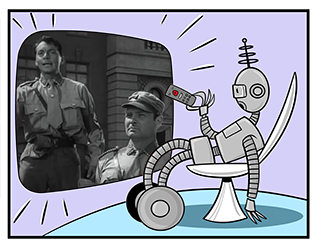Don’t Be A Sucker

In 1943, the Army Signal Corps produced Don’t Be A Sucker. This short 17-minute film was intended to boost the morale of U.S. soldiers by helping them understand the dangerous appeal of fascism. Four years later, the U. S. War Department shared the film with the general public, hoping to explain the ways that fascism might take root in the United States.1
The movie begins by profiling a young man named Mike who has just arrived in the big city. Noticing a crowd of people gathered around an angry middle-aged man standing on a soapbox, Mike stops to listen to the man’s speech.
“I happen to know the facts. Now, friends, I am just an average American. But I’m an American American. And some of the things I see in this country of ours make my blood boil. I see people with foreign accents with all the money. I see Negroes holding jobs that belong to me and you. Now I ask you, if we allow this thing to go on, what’s going to become of us real Americans?”
“What are we real Americans going to do about it? You’ll find it right here in this little pamphlet. The truth about Negroes and foreigners. The truth about the Catholic church.”
Mike follows along with the speech, nodding his head with each rhetorical beat, saying “it makes pretty good sense to me.” But the speaker continues to rant.
“I tell you friends, we’ll never be able to call this country our own until it is a country without… Without Negroes and foreigners. Without Catholics. Without Freemasons.”
At this point, Mike hesitates. “What’s wrong with Masons? I’m a Mason.”
The rest of the film dissects the speaker’s arguments, discussing the history of fascism, the need to preserve the rights of the minority, and the value of liberty.
This film is an ideal text for practicing skills of propaganda analysis because it can be analyzed at two levels. To start, one can dissect the logical fallacies, emotional appeals, and propaganda techniques used by the angry soapbox orator. After doing this, one can step back and evaluate this movie as a whole. After all, Don’t Be A Sucker is itself a propaganda film designed to persuade audiences that democracy is superior to fascism.
During the past two years, several insightful articles have been written about this film in publications such as The Atlantic,2 The Guardian,3 and Vox.4 These articles are well worth your time. However, we encourage you to spend some time watching and analyzing this film before you dig into these secondary sources.
- What persuasive techniques does the angry orator use in making a case for the importance of “real Americans?”
- What persuasive techniques do the filmmakers use in an attempt to persuade audiences that democracy is superior to fascism?
- Do you spot any contradictions in the film which undermine its message?
- Do you think this film effectively persuaded audiences who viewed it in 1943 and 1947? Why or why not?
References
1 Eunice Cooper and Helen Dinerman (1951) “Analysis of the film Don’t Be a Sucker: A study in communication” Public Opinion Quarterly, 12(1) 243-264.
2 Robinson Meyer (2017, August 13) “Why an Anti-Fascist Short Film Is Going Viral” The Atlantic.
3 Adam Gabbat (2017, August 14) “How a 1947 US government anti-Nazi film went viral after Charlottesville” The Guardian.
4 Alissa Wilkinson (2018, June 29) “This 1943 anti-Nazi film keeps going viral. It may be less effective than it seems” Vox.
